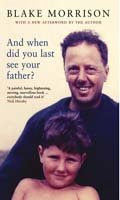
An old line goes, "There are no new stories, just new ways of telling them." We're living one of the classic stories in Alberta at the moment: boom and bust. Tonight's "
Reel Monday" film,
When Did You Last See Your Father? at Grandin Theatre (7:00 pm) explores one of the oldest stories, father and son and the quest for understanding. The film is based on the 1993 memoir by poet
Blake Morrison, which was an unflinching look at Morrison's conflicted relationship with his physician father. The book, and the film, intercut between Morrison at his dying father's bedside and Blake's funny, embarrassing and upsetting memories of his childhood and youth.
The book (whose title begins with "And" in the UK edition) was critically acclaimed on its publication, with
Nick Hornby, no slouch at understanding men's inner lives, blurbing: "A painful, funny, frightening, moving, marvelous book … everybody should read it."
Jay Parini, in the
New York Times, noted that is was a "small classic", one of few "books that say anything fresh about the death of a parent." Morrison's
website puts the book in a class with classic father-son memoirs by
Philip Roth (
Pa trimony
trimony),
Edmund Gosse (
Father and Son) and
J.R. Ackerley (
My Father and Myself).
[AWDYLSYF won the J.R. Ackerley Prize for Autobiography in 1993].
Mordecai Richler wrote about Toronto journalist
Joe Fiorito's father-son 1999 memoir,
The Closer We Are to Dying: "His splendid memoir about his relationship with his dying father belongs on that small shelf with
Philip Roth's
Patrimony and
Frank McCourt's
Angela's Ashes." Just rece

ntly the Library received
Peter Godwin's father-son memoir,
When a Crocodile Eats the Sun: A Memoir of Africa, an "exquisitely written, deeply moving account of the death of a father played out against the backdrop of the collapse of the southern African nation of Zimbabwe" (
Publishers Weekly).
The film of
AWDYLSYF has received good reviews, with a
Metacritic rating of 66 ("Generally Favorable") and 70% "Fresh" at
Rotten Tomatoes. One of the best reviews was from the very stingy
Rick Groen of the
Globe & Mail, giving it 3 1/2 stars and noting:

"A middle-aged son waits at the deathbed of his ailing father, sifting through his many and mixed feelings for the old man - reverence, hatred, envy, embarrassment, respect, frustration, love. Of course, none of these conflicting emotions is unique to him. They're felt, to varying degrees at different times, by most flawed sons toward most flawed fathers, all those patriarchs who are neither ogres nor saints. That's why this honest, unsentimental and, in the end, deeply moving film packs such a resonant charge: The relationship it explores may be specific and particular, but the wellspring it taps into runs wide and deep."
But enough about the thoughtful thought about mortality and the father-son chasm, this film stars the thinking woman's crumpet,
Colin Firth (aka
Mr. Darcy)! There, I've guaranteed a sell-out for the Friends of the Library showing tonight!
Jim Broadbent stars as the father, and it is interesting how Firth and Broadbent actually look like father and son.


 I thought I'd stumbled upon a satirical piece from The Onion when I saw the headline, "Wal-Mart Employee Trampled to Death". Sadly, it isn't a joke. A 34-year old man died when 2,000 "Black Friday" shoppers/idiots surged into a Long Island, NY Wal-Mart. Later the Black Friday toll moved to three dead as two men had gunned each other down in a California Toys-R-Us store. An added bit of madness in the LA Times report about the aftermath at the Toys-R-Us: "Many shoppers Saturday were slightly skittish." Is there nothing that will keep the North American shopper from their appointed rounds?
I thought I'd stumbled upon a satirical piece from The Onion when I saw the headline, "Wal-Mart Employee Trampled to Death". Sadly, it isn't a joke. A 34-year old man died when 2,000 "Black Friday" shoppers/idiots surged into a Long Island, NY Wal-Mart. Later the Black Friday toll moved to three dead as two men had gunned each other down in a California Toys-R-Us store. An added bit of madness in the LA Times report about the aftermath at the Toys-R-Us: "Many shoppers Saturday were slightly skittish." Is there nothing that will keep the North American shopper from their appointed rounds?
































